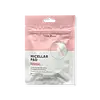What's inside
What's inside
 Key Ingredients
Key Ingredients

 Benefits
Benefits

 Concerns
Concerns

No concerns
 Ingredients Side-by-side
Ingredients Side-by-side

Water
Skin ConditioningPEG-6 Caprylic/Capric Glycerides
EmulsifyingGlycerin
HumectantPropanediol
SolventPentylene Glycol
Skin ConditioningCaprylyl Glycol
EmollientHyaluronic Acid
HumectantSodium Hyaluronate
HumectantHydrolyzed Hyaluronic Acid
HumectantEthylhexylglycerin
Skin ConditioningButylene Glycol
HumectantCitric Acid
BufferingSodium Phytate
Sodium Citrate
BufferingPhenoxyethanol
PreservativeTocopherol
AntioxidantAlpha-Glucan Oligosaccharide
CleansingHydrogenated Lecithin
EmulsifyingCetearyl Alcohol
EmollientStearic Acid
CleansingPolymnia Sonchifolia Root Juice
Skin ConditioningCaprylic/Capric Triglyceride
MaskingMaltodextrin
AbsorbentCeteareth-25
CleansingCeramide NP
Skin ConditioningCetyl Alcohol
EmollientLactobacillus
Skin ConditioningCholesterol
EmollientBehenic Acid
CleansingCeramide Ns
Skin ConditioningCeramide AP
Skin ConditioningCeramide EOP
Skin ConditioningPhytosphingosine
Skin ConditioningCeramide Eos
Skin ConditioningCeramide Ng
Skin ConditioningCeramide As
Skin ConditioningCaprooyl Phytosphingosine
Skin ConditioningCaprooyl Sphingosine
Skin ConditioningWater, PEG-6 Caprylic/Capric Glycerides, Glycerin, Propanediol, Pentylene Glycol, Caprylyl Glycol, Hyaluronic Acid, Sodium Hyaluronate, Hydrolyzed Hyaluronic Acid, Ethylhexylglycerin, Butylene Glycol, Citric Acid, Sodium Phytate, Sodium Citrate, Phenoxyethanol, Tocopherol, Alpha-Glucan Oligosaccharide, Hydrogenated Lecithin, Cetearyl Alcohol, Stearic Acid, Polymnia Sonchifolia Root Juice, Caprylic/Capric Triglyceride, Maltodextrin, Ceteareth-25, Ceramide NP, Cetyl Alcohol, Lactobacillus, Cholesterol, Behenic Acid, Ceramide Ns, Ceramide AP, Ceramide EOP, Phytosphingosine, Ceramide Eos, Ceramide Ng, Ceramide As, Caprooyl Phytosphingosine, Caprooyl Sphingosine
Ingredients Explained
These ingredients are found in both products.
Ingredients higher up in an ingredient list are typically present in a larger amount.
Butylene Glycol (or BG) is used within cosmetic products for a few different reasons:
Overall, Butylene Glycol is a safe and well-rounded ingredient that works well with other ingredients.
Though this ingredient works well with most skin types, some people with sensitive skin may experience a reaction such as allergic rashes, closed comedones, or itchiness.
Learn more about Butylene GlycolCeramide AP is formally known as Ceramide 6.
Ceramides are intercellular lipids naturally found in our skin that bonds dead skin cells together to create a barrier. Having a strong skin barrier leads to more firm and hydrated skin.
They are known for their ability to hold water and thus are a great ingredient for dry skin. By bolstering the skin ceramides act as a barrier against irritating ingredients. This can help with inflammation as well.
If you would like to eat ceramides, sweet potatoes contain a small amount.
Read more about other common types of ceramides here:
Ceramide NP
Ceramide EOP
Ethylhexylglycerin (we can't pronounce this either) is commonly used as a preservative and skin softener. It is derived from glyceryl.
You might see Ethylhexylglycerin often paired with other preservatives such as phenoxyethanol. Ethylhexylglycerin has been found to increase the effectiveness of these other preservatives.
Propanediol is an all-star ingredient. It softens, hydrates, and smooths the skin.
It’s often used to:
Propanediol is not likely to cause sensitivity and considered safe to use. It is derived from corn or petroleum with a clear color and no scent.
Learn more about PropanediolSodium Citrate is the sodium salts of citric acid. In skincare, it is used to alter pH levels and acts as a preservative.
Its main functions are to maintain the pH of a product and neutralize metal ions.
The acidity of our skin is maintained by our glands and skin biome; normal pH level of skin is slightly acidic (~4.75-5.5).
Being slightly acidic allows our skin to create an "acid mantle". This acid mantle is a thin barrier that protects our skin from bacteria and contaminants.
Learn more about Sodium CitrateSodium Hyaluronate is hyaluronic acid's salt form. It is commonly derived from the sodium salt of hyaluronic acid.
Like hyaluronic acid, it is great at holding water and acts as a humectant. This makes it a great skin hydrating ingredient.
Sodium Hyaluronate is naturally occurring in our bodies and is mostly found in eye fluid and joints.
These are some other common types of Hyaluronic Acid:
Learn more about Sodium HyaluronateTocopherol (also known as Vitamin E) is a common antioxidant used to help protect the skin from free-radicals and strengthen the skin barrier. It's also fat soluble - this means our skin is great at absorbing it.
Vitamin E also helps keep your natural skin lipids healthy. Your lipid skin barrier naturally consists of lipids, ceramides, and fatty acids. Vitamin E offers extra protection for your skin’s lipid barrier, keeping your skin healthy and nourished.
Another benefit is a bit of UV protection. Vitamin E helps reduce the damage caused by UVB rays. (It should not replace your sunscreen). Combining it with Vitamin C can decrease sunburned cells and hyperpigmentation after UV exposure.
You might have noticed Vitamin E + C often paired together. This is because it is great at stabilizing Vitamin C. Using the two together helps increase the effectiveness of both ingredients.
There are often claims that Vitamin E can reduce/prevent scarring, but these claims haven't been confirmed by scientific research.
Learn more about TocopherolWater. It's the most common cosmetic ingredient of all. You'll usually see it at the top of ingredient lists, meaning that it makes up the largest part of the product.
So why is it so popular? Water most often acts as a solvent - this means that it helps dissolve other ingredients into the formulation.
You'll also recognize water as that liquid we all need to stay alive. If you see this, drink a glass of water. Stay hydrated!
Learn more about Water